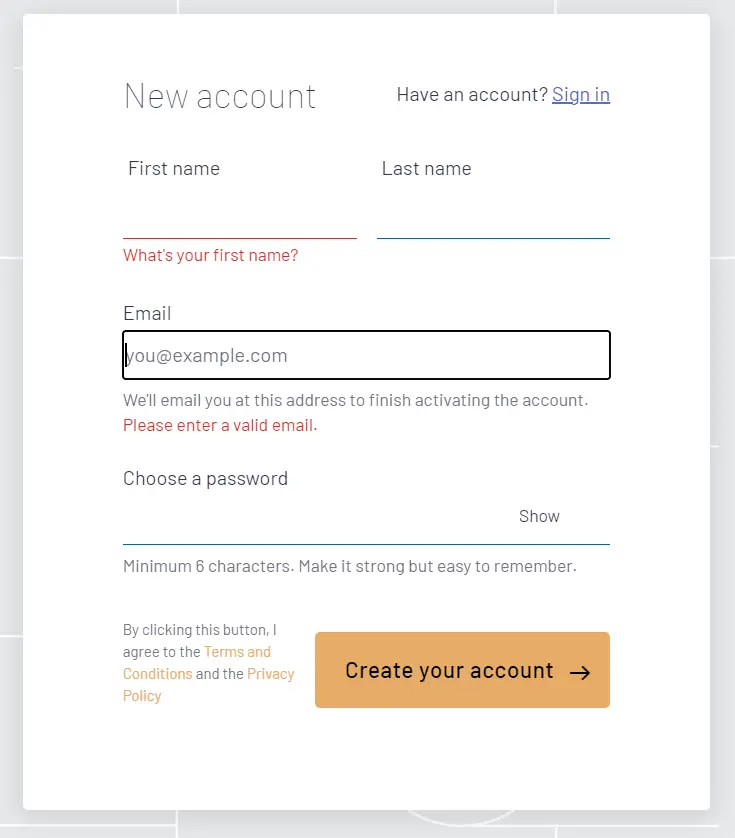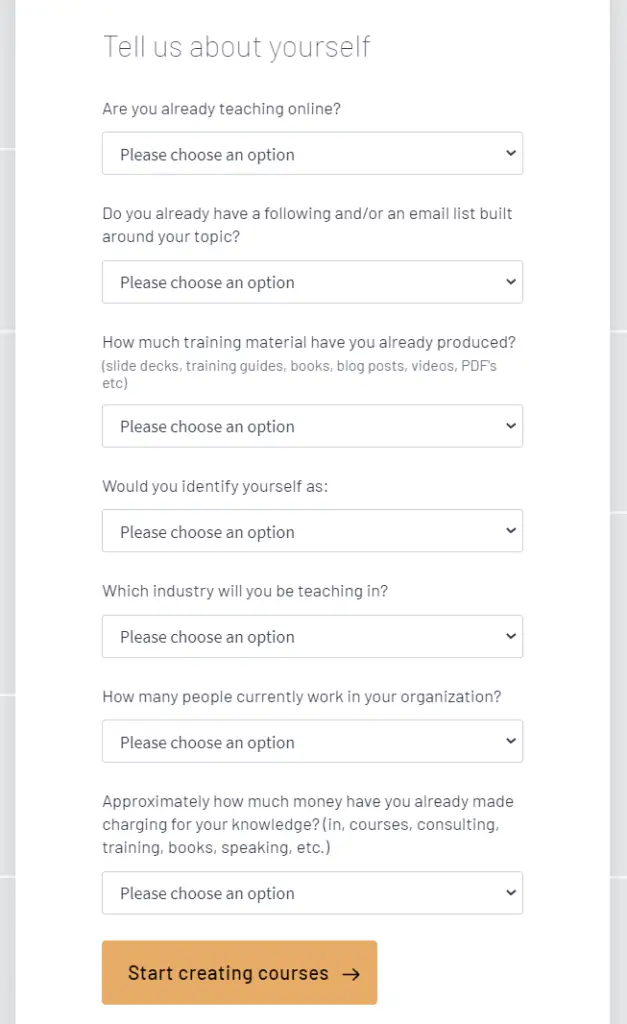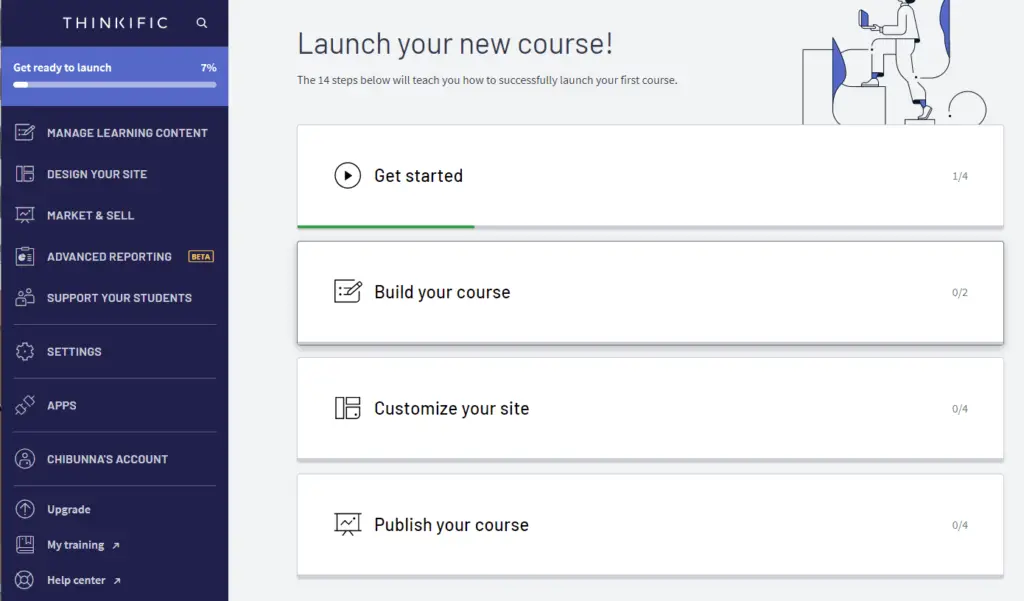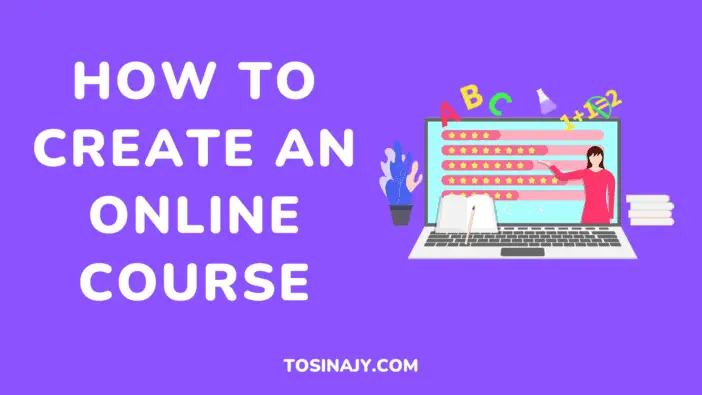Hold tight because I’m about to show you how to create an online course that pulls in learners like a charm.
Developing six-figure online courses does not, contrary to conventional assumption, necessitate a huge sum of money.
You are demonstrating that you understand what you’re speaking about, that you’re competent at what you do, and that you are an authority in your industry by teaching your topic.
This article will take you step by step through the process of how to create an online course. From picking the appropriate topic to choosing the ideal online course platform for your course and making a living out of your online course.
How to Create an Online Course
1. Identify a Problem to Solve
To begin, you must first identify the appropriate problem and opportunity. So how do you go about identifying the proper opportunity? By identifying and defining the issue.
Understanding precisely what objective your audience is searching for, what challenge are they attempting to tackle, is crucial to producing a successful online course.
Would they desire to learn PHP to become a programmer and progress their profession, or would they want to learn about paid traffic strategies to increase visitors to their sales page?
People seek to learn something different to transform themselves. The purpose of your online course is to assist them in undergoing that shift.
Discovering the problem that your audience aims to fix, on the other hand, is easier than it sounds. It will take some effort and investigation, but you must locate the appropriate moment before rushing off to develop something that you hope would be useful to anyone.
How to Detect Potential Challenges of Your Audience
Send an email survey to your subscriber base if you have one to find out what they’re having trouble with or what they’d love to learn.
To find out what your audience needs or wants, create a post or a survey on your social media networks.
Use internet forums such as Reddit, Quora, and Stack Overflow to find out what your target audience is talking about.
Is there a topic that’s generating a lot of buzz? Do you detect any recurring themes or patterns in the questions? Is there anything in particular that people constantly asking?
You should ideally have verifiable knowledge of the subject you’re teaching. This could be accomplished by experience, study, or knowledge of the subject.
It makes a great difference in building reliability for yourself if you have legitimate qualifications to present your students.
2. Do Some Research on the Topic
Are you already an expert in your industry or want to learn everything there is to know about it? That does not matter. Rather, now is the time to dig in and study everything there is to know about it.
The most critical stage of your course production is research and planning. If you don’t have a plan, you won’t be able to have an exceptional course.
Furthermore, you don’t want to be disseminating disorganized information that individuals can receive for free elsewhere.
Allow your imagination to run wild. Make a list of all the subtopics you’d like to cover in the course. On a piece of paper, jot down everything that comes to mind.
After that, conduct an online search and learn everything you can about the subject. You might already be a pro in the subject matter, but this extra step will make a huge difference.
However, there is constantly something new to discover. It’s critical to research what people are searching for, talk about online, and teach about your subject. You are the only one who is familiar with your area of expertise.
This will assist you in updating your brainstorming ideas and adding new subtopics, as well as finding fresh material and external connections to incorporate in your course.
3. Validate Your Concept
After you’ve chosen your online course topic, you’ll need to undertake a series of market research evaluations to see if there’s a market for it.
Many course authors naively believe that if their topic area has a large number of competitors, their course idea will fail.
However, this indicates that there is a good likelihood of significant market interest for that course topic, making it worthwhile to investigate further.
Surveying before you start will enable you to confirm that your online business idea is viable and will pay you in the long run.
Create a landing page for your online course using a landing page builder to test your idea.
You already know what the course will be about, even though you haven’t designed it yet. Include a brief description of the course that explains what students will learn, as well as eye-catching images that reflect the concept.
Use call-to-action buttons to encourage visitors to join up for your future online course for free or to pre-purchase it to reserve a space.
You’ll be able to check through the data you acquired after promoting your website through various channels such as online forums, newsletters, social media, and more to determine if you’ll have significant buyers.
Make a list of metrics ahead of schedule so you’ll know what to expect at the end of the trial period.
4. Make a List of Possible Learning Outcomes
Don’t overlook the significance of learning outcomes. If you don’t do this for your online course, you’re putting your reputation and business line in danger. Not only that, but you may also make the course-building process a chore.
Would you give someone your money for a thing that you don’t comprehend and don’t know what it would do for you? Obviously not.
All because you comprehend what your course will teach your students doesn’t mean they will understand it. Your learners are unlikely to enroll in your course if they do not understand how it will benefit them.
Learning outcomes describe what the student will be able to accomplish, know, and feel at the culmination of the course using quantitative verbs.
What significant skills or knowledge will they have gained as a result of your course? Also, what impulses have they moved away from or toward?
Explicit learning outcomes guarantee that only the most qualified students enroll in your course, resulting in higher participation and satisfaction rates and fewer refund requests.
5. Create a Course Outline
The most difficult aspect of developing an online course is writing an outline. This is where you will pick what information you will share and what information you will not disclose with your audience.
The internet is a vast space filled with queries and responses. Except you’re presenting something truly groundbreaking, your content is likely to exist in some version or another on the internet.
People, on the other hand, are not particularly purchasing for information; they are purchasing to be transformed.
The value of your course lies in its ability to take them from point A to b, or from where they’re at to where they aspire to be.
Starting with reusing your existing content is the simplest method to create a fantastic course plan. Attempting to produce wholly fresh content from the ground up can be a huge waste of time, and the effort may not be worth it.
Examine your current whitepapers, articles, blog entries, manuals, social media posts, and webinars for ideas. Make your best-performing content consumable in the form of an online course.
Realize that teaching is about taking your listeners’ step by step via an idea. Define a purpose for each of your sessions in your course plan to make this apparent.
Dividing your data into sections or modules is a good idea. Your student would have successfully learned a new skill or feature of your topic after completing a module.
6. Select a Delivery Method
It’s now time to choose the ideal method for delivering your material.
To ensure that your training is as compelling as possible, you must be aware of the many principles of adult learning, learning preferences, and all of the different ways that you can give it.
Will the course consist of reading material, videos, activities, or audio? What kind of visuals do you plan to use? Is there going to be a community learning center?
You must have a balance of auditory, visual, and practical approaches to ensure that everyone is engaged and receives the best learning experience possible.
7. Create the Course
It’s time to begin work on the course after you’ve filled in the holes in your plan. It is entirely up to you whether your course is audio, video, text, or a combination of all three—just ensure it makes sense for your students.
Create the material and deliver it flawlessly. To keep your audience engaged, include interactive components such as quizzes, assignments, and to-do lists.
Along the process, test your material on friends and coworkers to make sure you’re on the correct track. You don’t want this to end out like a physics class in high school.
SEE: Reliable Websites for Selling Online Courses
8. Host Your Course on Thinkific
When you’ve finished creating your course content, it’s time to put it all together on a platform.
If you already own a good website, you can make a section for your online course. Start a distinct website just for this if you don’t already have one.
Even better, you can use an online course platform such as Thinkific to host your newly produced course.
To get started with Thinkific, go to the homepage and sign up using the signup button at the top right corner.

After that, you’ll be routed to a page where you’ll need to fill out some basic information for your account to be established.

This will take you to a website where you must answer a simple question about your online selling experience.

After that, you’ll be taken to the admin section, where you can proceed to create your course.

While in your admin section, you’ll find that Thinkific is highly user-friendly, and you can alter the appearance and feel of your course site as well as import your logo by simply following the on-screen directions.
SEE: Best Membership Site Platforms to Your Host Online Courses
9. Set the Price
When it concerns pricing your course, you’ll want to find the sweet spot where the price is both reasonable and appealing to your students.
There’s a direct correlation between the cost of an online course and how involved your students are.
If you charge a higher price, your students will be more committed.
People are less likely to trust and have low anticipation for results when you offer your information free or cheap.
By raising the price, people instinctively believe they are getting more value. When consumers buy your course, they feel pressured to see a return on their investment right away. So, don’t be afraid to charge what your course is worth, not less.
Keep in mind that the majority of your courses should be priced considerably above $100 to aid you in this aspect. Only smaller courses aimed at attracting new students should be priced under $100.
Competing on price is the worst way to accomplish marketing. You can give discounts to attract price-sensitive or demanding customers, but competing on price with someone who offers a low-cost course is not a viable option.
Here are some methods for calculating your course fees:
1. Price comparisons
Begin by conducting a fast audit to establish the average pricing of your topic’s courses.
While rates may vary depending on the course instructor’s level of expertise, attempt to obtain a feel of what the prevailing market cost is for comparison.
2. Time of creation
Consider how long it cost you to develop the course. Any profitable business venture should strike a healthy balance between time and effort and money earned.
3. Course worth
The level of value the recipient will receive from joining the course is another consideration to consider when pricing your course. Will the paying student be able to earn money using the skills and tools you offered them later?
As you might expect, charging a greater price makes more sense the more the student can financially justify attending the course.
4. Best practice in general
Depending on the topic, course costs might range from a few hundred dollars to more than $20,000.
However, it has been discovered that the higher the price of a course, the more individuals believe they will receive a lot of value out of it and consider it to be “good.”
10. Recruit Beta Testers
When it comes to testing, you’ll want to identify your initial group of students as soon as feasible. This beta test group will go through your course and provide you with honest feedback. With this, you may make changes before releasing it to the broader public.
Your first group of students will serve as case studies, success stories, and brand ambassadors in the future.
You’ll figure out what works and what doesn’t with your course through them, and they’ll give you crucial advice on how to proceed.
Any well-designed course should be geared to assisting students in their personal change.
The beta testers should be those who are similar to your target audience. In reality, you could undertake a test run with a small group of interested people.
Finding testers for your online course by joining Facebook groups in your topic area is a great approach to get started.
You need the student’s point of view, no matter how tiny or huge this level of reviewing is, to ensure that you’re communicating your knowledge correctly.
Good beta tester feedback can be used as testimonials on your online course’s sales page. If the evaluation isn’t favorable, you’ll have the opportunity to swiftly improve it before launching it to the wider public.
11. Launch and Market Your Online Course
If you believe your work is done now that you’ve finished your online course, think again. The actual work just got started.
Many course owners make the mistake of believing that once their course is published, they would automatically have an income stream.
To advertise your course and recruit students, you’ll need a launch an ongoing marketing strategy.
Make sure you have a long-term marketing strategy in place for your online course and remember that the moment you stop marketing, you stop selling.
12. Form a Course-Related Community
Even introverts require social interaction in a learning setting, which is something that cannot be overlooked. That’s where technology comes into play once more.
You should create a community for your learners, whether it’s through a Discord channel, Telegram or WhatsApp group, a Facebook group, or any other method you can think of.
What is the point of this? A community that extends beyond your classes and modules provides students with a platform, which is a significant benefit. Creating a strong community is a crucial element of learning how to create an online class.
Let’s imagine you have a learner who didn’t fully comprehend the last lesson. He has a few options, but the majority of them are troublesome. For a variety of reasons, they may be apprehensive to approach you, the teacher.
If you give this lost learner a place to communicate with their peers, they may ask their peers to assist them to fill in the voids in their knowledge, and thereby helping them to easily grasp your course content.
Another reason is that feedback is important. You can use a social network to see how your learners are doing. Check out who usually seems to be behind; you’ll be able to tell who needs a little extra support at a glance.
If a specific lesson seems to be causing a lot of complaints, you could ask them what they found challenging and switch it up. Everybody is a student, together with the teacher.
13. Promote Your Online Courses
As you may be aware, “no marketing equals no sales, and no business”. Therefore, now that your course is set to be released, you must consider how to reach your intended audience.
There are a plethora of techniques to market a course, and the following are just a few of the most effective:
1. Create a Blog
You may establish a devoted following by learning basic SEO and writing blog posts where you share your knowledge regularly.
Some of your readers will certainly want to buy your course if you write blog posts where you share your experience regularly.
Although blogging may appear to be a long-term marketing approach, it is one of the most tried-and-true methods of promoting online courses. Your tribe will eventually find you.
SEE: How to Create a Blog as an Utter Newbie With No Techie Skill
2. Boost Your Profile on Social Media
Instagram, Facebook, Tiktok, LinkedIn, YouTube, and Twitter are all great places to connect with and engage with your target audience.
Provide backlinks to your course sales page for prospective audiences by publishing interesting, thought-provoking blogs and videos. You may use social media to build and expand your communities as well.
3. Make Use of Email Marketing
Once you have the emails of people who have shown interest in your course topic and have permitted you to contact them, you get a level of control over your eLearning business that the other marketing platforms can’t match.
You have complete control over how you communicate with prospective buyers. Encourage people to sign up for your email list on your site, on social media, and elsewhere.
Send out emails regularly with valuable and entertaining content that relates to the knowledge in your course.
SEE: Best Online Course Platforms
FAQs
What is your earning potential with an online course?
Of course, it all depends. Your earnings can range from nothing to infinity.
The pricing of your course, the specialization of your sector, and the scope of your niche are all factors that will determine how much money you can make by offering online courses.
However, if you can provide excellent content and reach your target market, creating and selling online courses can be highly profitable.
What is the definition of an online course?
An online course allows you to acquire a new skill or expand your knowledge while sitting in the comfort of your own home.
They might be paid or given away for free. Some are provided by educational institutions, while others are created by industry specialists. The most critical aspect of an online course is that it is engaging and produces a clear result.
Conclusion
Awesome. You’ve concluded a lengthy post on how to create an online course. Now it’s only a matter of putting what you’ve learned into practice.
Return to the beginning, grab a pen and paper, and follow this instruction step by step, starting with identifying the problem that your course will solve.
It takes a lot of time and energy to create an online course, and it also requires a lot of flexibility. You’ll have to alter your approaches regularly based on a variety of circumstances.
Creating online courses, on the other hand, is a terrific way to get your foot in the door of teaching if you’re ready to put in the effort, to pour your skill and your heart into your work. It’s nearly hard to do everything right the first time you design an online course.
As a result, as an online course instructor, your workflow should constantly include listening to your students’ input and updating your course based on that feedback.
It’s also worth noting that no course will ever be obsolete. Students’ learning needs alter regularly, as does the competition from other instructors.
This implies that course instructors can’t anticipate a single high-quality course to function well for ten years without any changes to the content.
Tosinajy tells you how to make an income online, the tools you’ll need, and how to cope with typical problems you may encounter in the process.
Thanks for reading.
Ready to create your online course using Thinkific?
Click the link below to sign up with Thinkific and start creating your online course.

